Interview with Gretchen Aiyangar on Staging a LCTL Escape Room
DOI: https://www.doi.org/10.69732/OHAJ9901
For this issue of the FLTMAG, Shannon Spasova interviewed the language program coordinator of the LCTL Center at the University of Pittsburgh, Gretchen Aiyangar, and the team that helped her to stage an escape room promoting less commonly-taught languages.
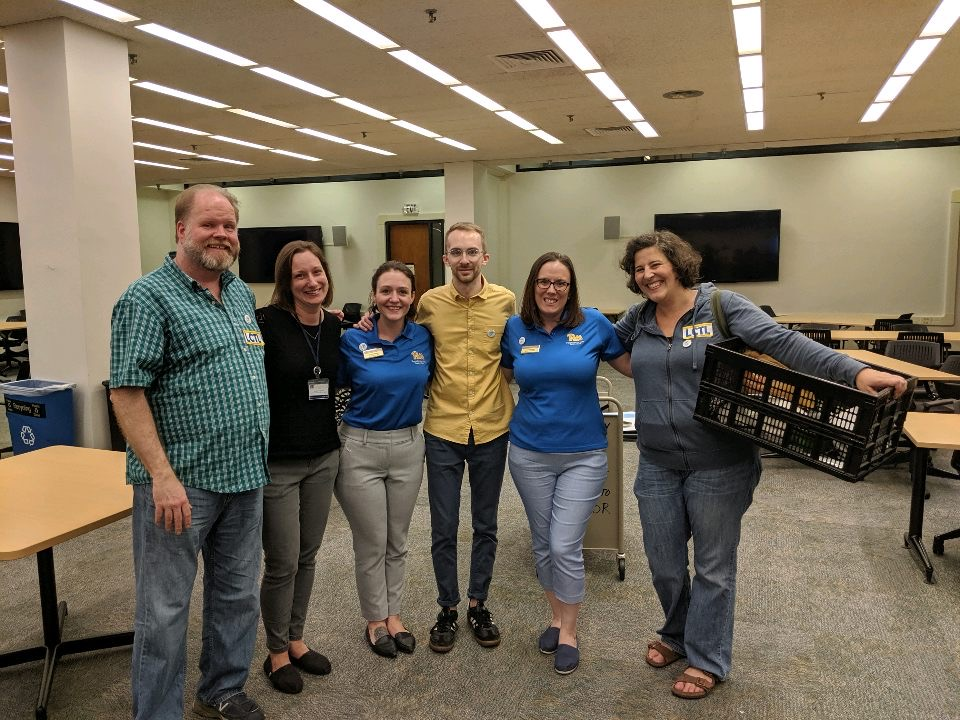
Shannon: How did you get the idea to do an escape room with LCTLs? What were you hoping to achieve with this project?
Gretchen: Visibility is one of the largest issues we face as a small center at a large university. We often encounter students who are ready to graduate and only now discovering that we offer such a wide array of languages. In an attempt to promote our courses and our center, we have started hosting a variety of campus-wide events, including Mini Language Lessons and Language Coffeehouse. During Mini Language Lessons, instructors teach a series of 15-minute lessons and students can sample multiple languages in a simulated classroom environment and a speed-dating type format. During Language Coffeehouse, participants must learn and then activate their newly acquired language skills as they try to order snacks and drinks in a variety of languages, and our language students get the opportunity to become the experts and the teachers. This year we wanted to try something more game-like, and something that would allow us to collaborate with other Pitt entities, like the University Library System and the Office of Residence Life. The idea of an escape-room bubbled up out of brainstorming sessions between LCTL faculty and staff. Some of our younger staff and student workers brought particularly creative ideas to the table, and we fleshed out the concept over the course of the summer. As we worked together with Residence Life and the University Library System, we added the goals of offering a team-building experience and an introduction to library resources for incoming students. The collaboration was exciting and productive. From our perspective, Residence Life had access to the entire population of first-year students, a desire to offer academic programming, and a funding stream for orientation events. The libraries had space and housed many amazing and new resources like a VR lab and a 3D printer. Getting students into the library in the first week of classes, exposing them to exciting technologies, and asking them to do things like look up call numbers and find books on reserve was something that appealed to all three of our organizations, and it was easy to use LCTL languages as the subject matter to teach a variety of skills.
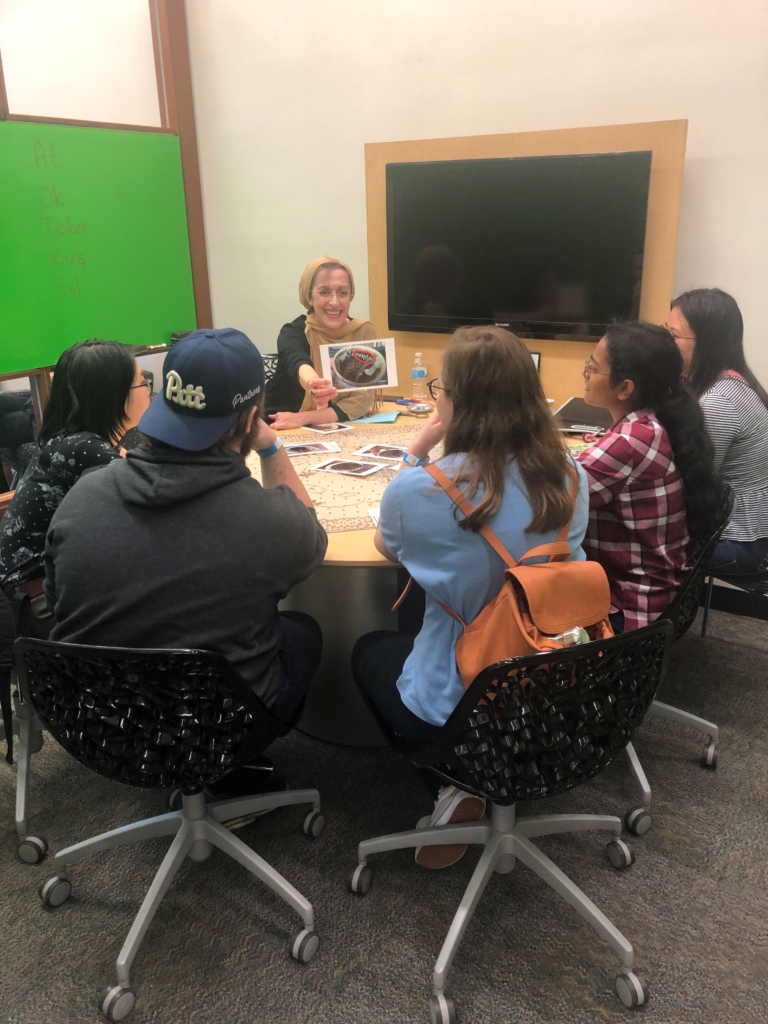
Shannon: Some of our readers might not be familiar with the concept of an escape room, could you please briefly describe how an escape room works in general? What modifications (if any) were needed for a LCTL escape room?
Gretchen: So…to be really honest here, I hadn’t ever done an escape room myself prior to this experience. I still haven’t. We’ve got a date set in October for our organizational team to try out one of Escape the Room’s scenarios on Pittsburgh’s South Side, which we are all really excited about. I’m sure we’ll come out of there with a lot of ideas for the next time we run our own. But very briefly, and to the best of my understanding, an escape room is a timed game in which a team of people has to work together to solve a set of puzzles or locate and decipher clues that lead them to accomplish a specific goal (usually escaping from the room they have been locked into) in a designated amount of time. Escape rooms are usually designed around a theme. As I’m sure you can imagine, we didn’t want to actually lock a group of new first-year students in a room. But we did want to simulate the pressure of an escape room, so we settled on an airport scenario and gave teams 30 minutes to collect 4 top-secret documents (Intro Language Syllabi) and make it to their departing flight. Instead of limiting students to one room for the event, we transformed Hillman Library into the Library International Airport and created signage and maps for all of the various locations (ticketing and check-in, security, information desk, ground transportation, duty-free books, etc.). This allowed students to see practical applications of ways they can use library spaces and technologies. Student teams played the role of LCTL Special Agent Linguists and were pitted against a common enemy, the Society for the Preservation of Monolingualism (SPoM). Instead of locking doors, we used padlocks to secure puzzles and documents inside of locked boxes and hid envelopes in books in the stacks. We included many interactive puzzles that required the help of language instructors, and in some cases, these instructors handed over the clues for the next puzzle once students had participated in and solved the interactive part. In order to give as many students the opportunity to participate as possible, we reset each “room” (or “track” as we referred to them) as soon as one team had finished. Over the course of two hours, we managed to run and reset each track approximately three times.
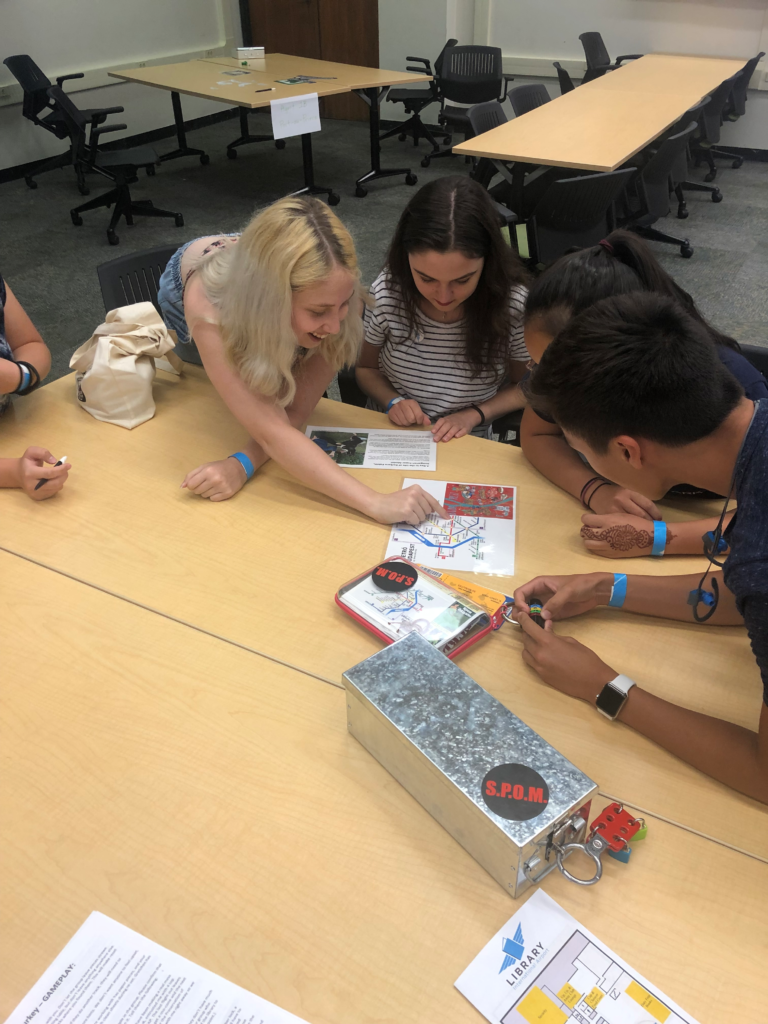
Shannon: What preparations did you have to do to get the escape room ready? How long did it take you? Where did you find your inspiration for the things you included in it?
Gretchen: We began meeting with Residence Life and the University Library System late in the spring semester (April 2019). At this point, we had a rough premise for the project but hadn’t begun creating puzzles or building tracks. This team of librarians, LCTL core staff, and Res Life directors (the Organizational Team) met regularly over the course of the summer to plan and troubleshoot the logistics of the event. We researched and reviewed presentations from other libraries that had conducted escape rooms. Language instructors were briefed about the event in June and asked to come up with 3 puzzle ideas by mid-July. These ideas were sometimes completely envisioned puzzles, but more often than not were more conceptual in nature, and gave us a starting point to work from. We incorporated puzzles from 17 different languages and cultures, including several languages taught in other departments outside the LCTL Center. Collaboration across language departments is always a really rewarding experience for us, and we like the idea of working together to present students with all of their language options at once. It was important to us to start with the instructors’ ideas about what to highlight and focus on for each language and culture rather than create a puzzle template. This organic development kept the agency in framing the representation of each language with the instructor and led to a greater variety in puzzle type. Of course, it also meant a lot more work for LCTL staff as we put together the eight tracks of four puzzles each. We had to make sure that each puzzle was self-contained and relatively quickly solvable, that each puzzle imparted some small aspect of the language or culture they represented to students in a very succinct way, and that the puzzles flowed together to create tracks in a logical way. Because of our collaboration with the libraries and Res Life, and our additional goal of highlighting as many library resources as possible, including the VR stations, the 3D Printers, the stacks, the reserves, the Cup & Chaucer café, and the Digital Scholarship Commons, we had to work these library resources into the puzzles and into the tracks as well. Then we had to physically construct the puzzles and clues. Faculty had to develop and know their roles for interactive puzzles, and be ready to participate. Clues had to be ordered correctly and hidden in the correct locations. Group leaders had to understand the rooms’ trajectories and be ready to help in solving puzzles. The library communications team created a Library International Airport logo and signage corresponding to a map of the airport that teams received as they started their experience. We also made buttons with the logo which were popular among participants. So, in short, a massive amount of collaboration was required to make this event happen. But we are certainly stronger for that experience, have made valuable connections across departments and units, and are now in a better position to serve our students, having learned a lot from our colleagues along the way. We will definitely try this again!
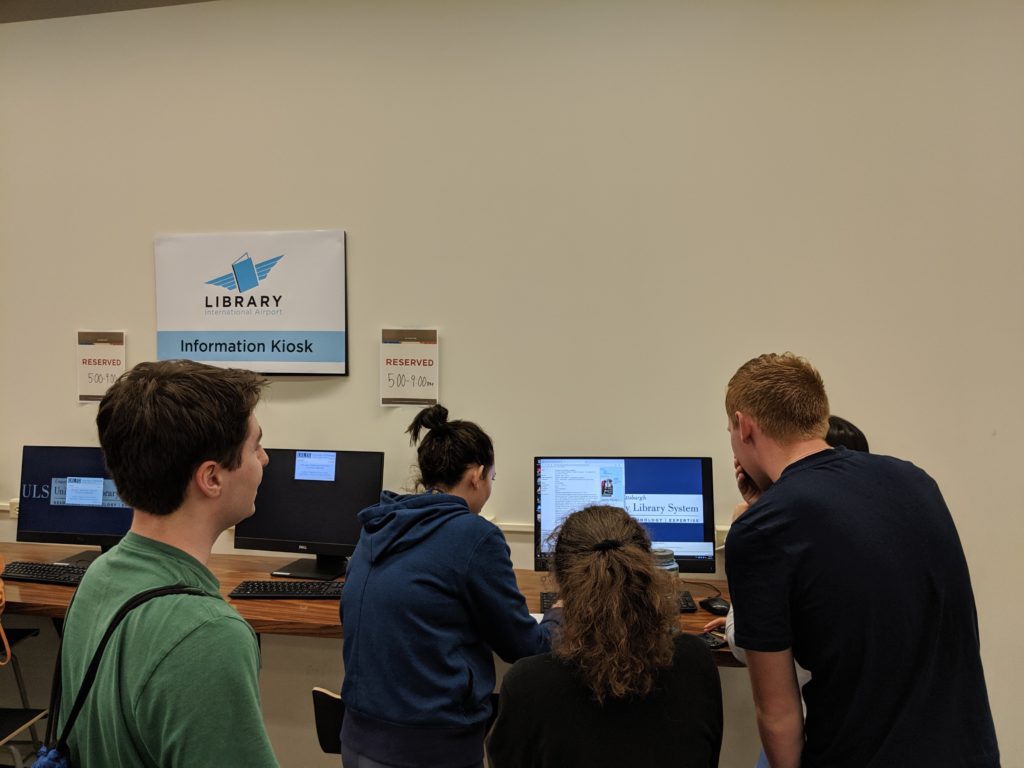
Shannon: What was your budget for this project?
Gretchen: The total cost for the event was just shy of $750. This included all of the supplies (boxes, locks, paper, blacklight pens, lamination sheets, etc.) as well as the prize for the winner (two tickets to Escape the Room).
Shannon: Could you give us an example of a riddle that was included in the escape room?
Gretchen: We included a wide variety of puzzles based on 17 languages and cultures taught at Pitt. Generally, the puzzles fell into the following categories:
- Decoding/Transliterating an unfamiliar alphabet
- Vocabulary learning and use in some format
- Learning and implementing an unfamiliar word order in some format
- Interactive/Immersive puzzles
- Virtual Reality puzzles
- Learning and implementing tone patterns
- Learning and implementing some aspect of culture, independent of language
It was very tricky figuring out how difficult to make each puzzle. We did some beta-testing in Hillman library with volunteer participants at the end of July to make sure we were on the right track and adjusted some of the puzzles based on feedback we received. We also ran many of the puzzles past our colleagues and student workers in the Department of Linguistics. As I mentioned before, teaching faculty from each of the languages were involved in developing the puzzles for that language, which had the happy result of a very diverse assortment of puzzles and puzzle-logic, and a satisfying result that was representative of our individual language programs. Here is an example of a Greek escape puzzle and of a Chinese escape puzzle.
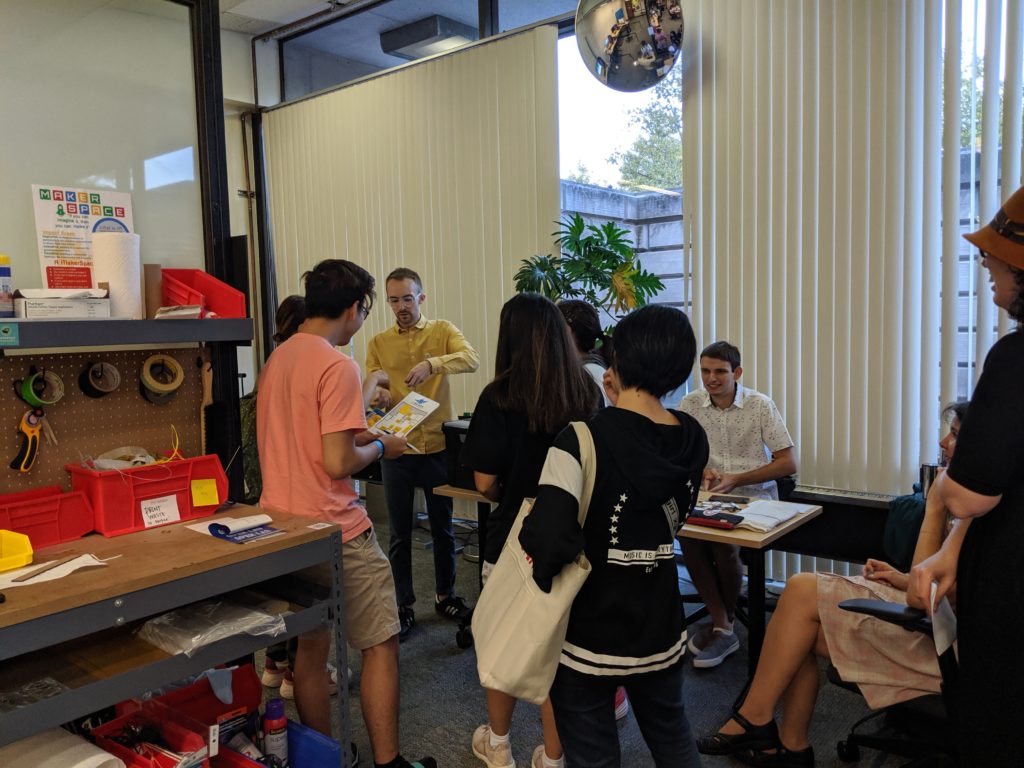
Shannon: How was technology involved in the escape room?
Gretchen: We tried to integrate as much of the library’s technological resources as possible into our puzzle design. Open Lab @ Hillman, a collaboration between the University Center for Teaching and Learning and the University Library System, provides the Pitt community with training and access to a variety of innovative technology and experiential learning opportunities. Open Lab technology was used in the following ways:
- We used the 3D printer to create plastic tokens representing a variety of foreign currency that had to be exchanged at current exchange rates in order to purchase snacks from the food court in a variety of languages.
- We used the vinyl cutter to create vinyl-cut stickers for marking locked boxes and envelopes with the SPoM logo.
- We used the VR lab and 360cities.net to set students into different virtual environments and locations around the world where they would have to search for answers to clues without leaving Hillman library.
Additional library-related technology was used in the following ways:
- We used the One Button Video recording studio to create a video news broadcast from the “International Library Airport News Network” with relevant puzzle commentary that we played on a loop on library screens during the event.
- Some of the puzzles required students to look up books by author, title, or call number in the online library catalog and then locate those books in the stacks.
- Some puzzles required students to look up individual instructors in the library reserves system and then ask for a specific resource at the reserves desk.
- Many of the individual puzzles involved multi-media components, including laminated jigsaw puzzles, an Andean khipu made of cotton fiber, vocabulary flashcards, pamphlets, satirical newspaper articles, and simulated art exhibits.
Students were instructed on arrival that they needed to put all electronic devices in their checked luggage and rely solely on library resources to solve the puzzles.
Shannon: Who was on the escape room team?
Gretchen: Amanda Ries is the Res Life Assistant Director specifically responsible for Academic Initiatives, so she is always looking for campus academic partners. This escape room experience ticked all the boxes she was looking for when developing academic programing for Res Life: 1) campus partnerships (ResLife/ULS/LCTL); 2) opportunity for engaging residential students outside the classroom; 3) highlighting campus academic resources; 4) demonstrating collaboration between the residential and the academic experiences. The LCTL Center doesn’t have the budget to pull off this type of event on our own, so we were thrilled to have the support of Res Life from a financial perspective, but also because of the insight they have into the student experience and perspective, and the people power and energy they bring to their work. Collaborating with the University Library System added the dimension of all of the library resources and the help of librarians and library support staff. In so many ways we could not have had a more ideal partnership. The team members (see the full list at the end) divided up all of the logistical tasks involved in making this project work, including booking the venue, creating signage, advertising, purchasing, coordinating staffing, creating the physical puzzles, beta-testing the puzzles, etc. Language faculty played an essential role in coming up with the original puzzle ideas and staffing the interactive puzzles. Language students also assisted in staffing some of the puzzles. Residence Life played a key role in staffing the non-language-specific roles, including welcoming and greeting students, ticketing and check-in, security, group leaders, and gate agents. Group leaders were a mixture of students, faculty, and staff who were given a basic script, detailed instructions on the trajectory of their track and the gameplay of each puzzle in the track, and instructions for resetting the track for the next group. As you can see, this endeavor involved a heavy commitment from many people across multiple units at the university.
Shannon: What do you think was the most successful outcome of the escape room?
Gretchen: This event was extremely successful in multiple ways:
- Enormous student interest. We had such a large turnout, we had to turn students away. Please see this article in the Pitt News for a student’s perspective. Many of the students attending were first-year students. Because the event happened within the first few days of classes, we hope that it helped to alleviate library anxiety for these students, and made them aware of language offerings on campus.
- Perceived buzz on campus. Anecdotally I heard from faculty, staff, students, alumni, advisors, people in the dean’s office, and community members that people were talking about our event all over campus. This indicates to me that the event helped in boosting our visibility.
- Collaborative relationship with ULS and Res Life. This event continued to establish our collaborative relationship across language departments, but the biggest and most surprising benefit was the strong relationship we developed with the University Library System and Residence Life. Our core team worked really well together and each unit brought their own unique perspective and resources to the event. We are looking forward to the next collaboration. I am very excited to see what types of things we are able to work on together and how this relationship will benefit students at Pitt.
- We ran a successful program that we should be able to tweak with relative ease and re-use next year with incoming students.
Shannon: If you do it again, what tweaks will you make? Do you have any suggestions or advice for instructors who might want to do an escape room at their own institution?
Gretchen: I’m sure there are many things we will tweak slightly based on group-leader feedback about individual puzzles. Our librarians have expressed interest in incorporating more information literacy into our puzzle design. One thing I’d like to work on is a reservation system and a strict time limit that will allow more students to participate with shorter wait times. After running the event once, we have a much better feeling for how long each track will take to complete, and we have ideas about how to improve efficiency.
Here are my best suggestions for building your own language-based escape room:
- Get a solid core team that’s willing to work hard and play hard.
- Give your language instructors agency in determining the content and themes for puzzles, and make sure they feel good about the final forms that the puzzles take.
- Have a trial run! Test your puzzles and tracks out well in advance. Ideally, make this test run a training for your group leaders. In our beta testing, librarians and library specialists were some of the testers, and this helped create a buzz around the event once testing was complete. It also gave participants and faculty volunteers time to practice and provide feedback.
- Make sure you have clear and solid documentation and organization, and that your instructions are communicated clearly to all participants.
Shannon: Thank you very much Gretchen!
About our team
This project was the outcome of a solid core team made up of 2 LCTL staff members, 2 Library System representatives, and 2 Residence Life team members:
- Gretchen Aiyangar, Language Program Coordinator, LCTL Center, gma21@pitt.edu
- Kayla Dunn, Area Coordinator, Office of Residence Life, kayladunn@pitt.edu
- Claude Mauk, Director, LCTL Center, cemauk@pitt.edu
- Leslie Poljak, Outreach and Engagement Librarian, University Library System, l.poljak@pitt.edu
- Amanda Ries, Assistant Director of Academic Initiatives, Office of Residence Life, amanda.ries@pitt.edu
- Michael Thompson, Events Coordinator, University Library System, mjt96@pitt.edu
About the University of Pittsburgh LCTL Center
The Less-Commonly-Taught Languages (LCTL) Center is housed in the Department of Linguistics in the Dietrich School of Arts & Sciences (DSAS) at the University of Pittsburgh (Pitt). Pitt is a large state-related research university with about 35K undergraduate and graduate students spread across five campuses. Our courses serve undergraduate and graduate students at the main campus in Oakland, a neighborhood in Pittsburgh’s East End. The LCTL Center was established in the 1970s to expand the language study options available to students. Our mission continues to be to expand the geographic and linguistic diversity of language offerings at the University of Pittsburgh. Approximately 30 languages are offered at Pitt on a regular basis, many of which are housed in traditional language and literature departments (East Asian Languages & Literatures, French and Italian Languages, and Literatures, German, Hispanic Languages & Literatures, Slavic Languages & Literatures, and Classics). Hebrew is offered out of the Jewish Studies Program. The LCTL Center’s offerings may fluctuate, but we generally offer between 10 and 15 languages. We currently offer instruction in 14 languages: American Sign Language (ASL), Amharic, Arabic, Modern Greek, Haitian Creole, Hindi, Hungarian, Irish, Persian, Quechua, Swahili, Swedish, Turkish, and Vietnamese. Of these, ASL and Arabic are our largest programs, with multiple instructors, large student populations, and long-standing certificate programs. As of last year, we offer minors in 10 languages: Modern Greek, Hindi, Hungarian, Irish, Persian, Quechua, Swahili, Swedish, Turkish, and Vietnamese. We offer up to 4 years of instruction in most of these languages, and many of them have been taught consistently at Pitt for 30 years or more. Our Amharic and Haitian Creole programs are relatively new and accordingly smaller.
Our partners in this undertaking were the Office of Residence Life and the University Library System.

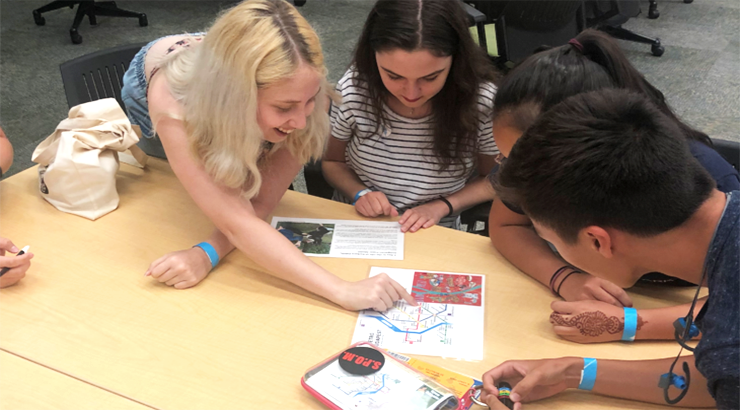
Glad to see the University of Pittsburgh, my alma mater, continues to innovate and distinguish itself from other universities. Pitt is better than ever.
Adam J. Stryker
BA Education 1987
That sounds like a wonderful project – well done. Inspiration for us all.
Monica Ward, Chair LCTL Eurocall.